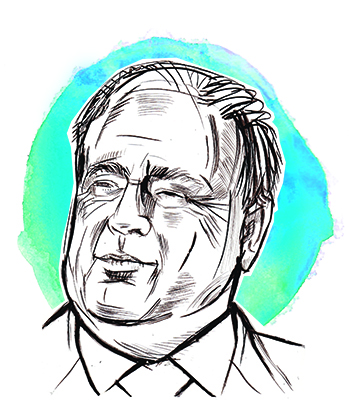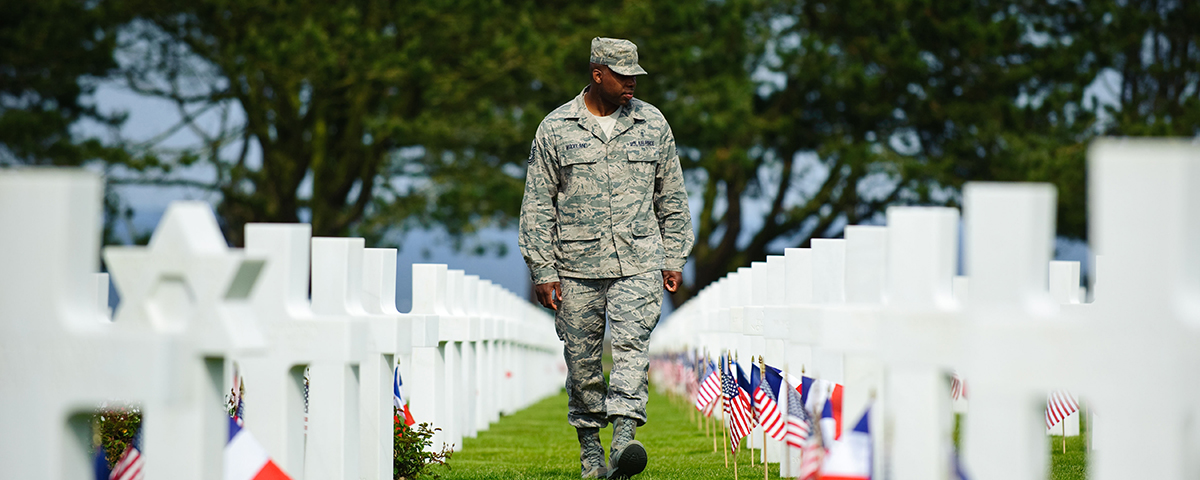Created by Congress in 1923, the American Battle Monuments Commission was established to design, construct, operate and maintain cemeteries and monuments worldwide to commemorate the service and sacrifice of U.S. armed forces. The ABMC currently operates 25 permanent overseas American military cemeteries and 27 memorials, monuments and markers. In 2009 President Barack Obama tapped Joseph Maxwell “Max” Cleland, himself a decorated veteran, to be secretary of the commission. Born and raised in Georgia, Cleland served in the U.S. Army during the Vietnam War, rising to captain and receiving the Silver Star and Bronze Star for valor in combat. When he was 25, a hand grenade accidentally dropped by a fellow soldier exploded at Cleland’s feet, inflicting injuries that forced the amputation of Cleland’s right forearm and both legs above the knee. After serving in the Georgia state government, he was appointed administrator of the U.S. Veterans Administration under President Jimmy Carter and later represented his home state in the U.S. Senate. Cleland continues the legacy of the ABMC through education and recognition of those who gave their lives in service to the nation.

What spurred creation of the ABMC?
Initially, the ABMC was an extension of the U.S. Army’s Graves Registration Service. After World War I families were given a choice: Their deceased loved ones could be brought home or interred where they fell. General John J. Pershing, commander of the American Expeditionary Forces, began to see the need for order and honor in terms of interring our fallen. The Graves Registration Service was set up outside of Paris, and that is where we have our first cemetery, Suresnes. In 1923 Pershing’s desires came true with the creation of the American Battle Monuments Commission.
How did the commission evolve?
After World War II General George C. Marshall, the wartime Army chief of staff, took over as ABMC’s chairman. Under his guidance the organization set out on a 15-year journey to create World War II cemeteries. The ABMC collated and identified many of the bodies, designed the cemeteries and commissioned the works of civic art to create this powerful sense of awe and respect the visitor experiences.
Can you describe some of the sites?
We have cemeteries in 14 nations and markers in 19. The markers memorialize such places as the Japanese-run prisoner of war camp at Cabanatuan in the Philippines, where in 1945 special operations forces went behind the lines to rescue more than 500 Allied POWs. The names of the people who died in that camp are engraved on plaques there.
We’re also going to put a marker in New Zealand as a tribute to American troops stationed there in World War II. Similar efforts are going on in Australia and Iceland.
What is the overarching mission of the ABMC?
Referring to America’s war dead, Pershing liked to say, “Time will not dim the glory of their deeds.” That idea has become the ABMC’s mantra. Since the Korean War we have flown home all of the remains that have been identified, and we have not built and dedicated a new cemetery since 1960. We don’t foresee building cemeteries in Afghanistan or Iraq, so our mission of burying America’s war dead overseas is over.
Our task now is to tell our nation’s succeeding generations that the world in which we live was in large measure brought about through the deaths of those who went overseas to fight for this country and never returned. And the numbers are staggering: 125,000 American war dead are buried abroad, and 8,000 of them have not been identified. We also list the names of more than 94,000 Americans missing in action, lost at sea or buried at sea from the world wars, Korea and Vietnam. Each cemetery features walls of the missing on which those Americans are commemorated by name. The U.S. government is still working to recover and identify bodies from as far back as World War I.
What are ABMC’s goals?
We are in the business of telling the story of our deceased service members so that “Time will not dim the glory of their deeds.” When people visit the cemeteries at Normandy, Meuse-Argonne and elsewhere, we provide them an interpretation of that experience, that particular conflict, including key personalities. With every tool at our disposal—interpretive centers, websites, phone apps, other means of communication—we are telling the story.
Is ABMC also active stateside?
Yes, we have three memorial sites in the United States.
There is the East Coast Memorial in Manhattan’s Battery Park, which memorializes those killed aboard the 200 ships sunk by German submarines off the U.S. coast during World War II. It centers on a massive statue of an eagle, dedicated by President John F. Kennedy in 1963, that overlooks the Statue of Liberty. The memorial includes the names of the thousands lost and missing.
The similar West Coast Memorial overlooks the Golden Gate Bridge in San Francisco and lists the names of those missing in the Pacific coastal waters.
And in Honolulu the National Memorial Cemetery of the Pacific (aka Punchbowl Cemetery) lists the names of 18,000 missing in the Pacific Theater from World War II, 8,000 missing from the Korean War and 2,500 missing from the Vietnam War. The memorial also includes maps of significant battles in each conflict.
What other sites does ABMC manage?
Another is the ABMC cemetery in Panama, where many of those who built the Panama Canal are buried. We still arrange about eight burials a year, since we’re entitled to bury veterans there.
We also are responsible for the cemetery at the former Clark Air Base in the Philippines. When the United States withdrew from its Philippine bases in the early 1990s, the Clark cemetery was left behind. It dates to about 1900 and is the final resting place of Spanish-American War veterans, military family members and others. Congress determined the ABMC should take responsibility for restoring the cemetery, whose headstones were covered with material from the 1991 eruption of nearby Mount Pinatubo volcano.
What are ABMC’s greatest challenges?
The possibility of further terrorist attacks in Western Europe is a concern. We have three cemeteries in Belgium, and when that nation went on alert after the terror attacks in Brussels, our cemeteries were put on alert. About 40 percent of all of our cemeteries are within driving distance of Paris, which, of course, was also was the scene of a large terror attack. Who would have ever thought an American cemetery abroad would be a target for terrorists?
But we have to consider the possibility in order to protect our cemeteries. Congress realizes we are under threat to a certain extent in Western Europe and has authorized us additional funds for security measures. We are also in frequent communication with the security and intelligence services in Western Europe. We are on an emergency forward planning effort, to protect our people first and our property second.
What does ABMC mean to you personally?
It is a continuation for me of being able to say that this country’s freedom and independence do not come cheap—they were bought with a price. When we put together the Vietnam battle maps in the Punchbowl Cemetery, I asked for an inscription to be added, from the poet Archibald MacLeish: “We leave you our deaths. Give them their meaning.” That’s what it means to me.
My job is to continue to tell the story. The best message is to go to an American Battle Monuments cemetery abroad. All you have to do is be quiet, and you’ll get the message. MH





